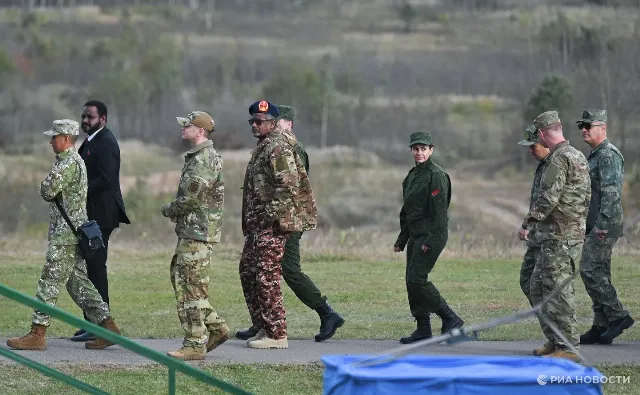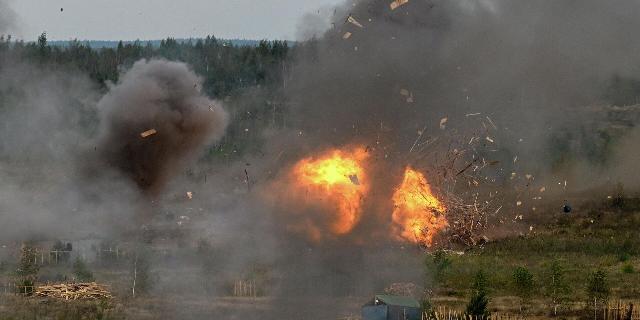CNN: The United States is watching the Zapad-2025 exercises, and its NATO allies are nervous
On Monday, a CNN reporter visited the Borisovsky training ground, a huge complex north of the Belarusian capital where Russia and Belarus are conducting large-scale exercises. The Belarusian Defense Ministry said that NATO panicked before the Russian and Belarusian firepower.
Frederik Pleitgen
At a time when the United States' NATO allies in Europe are increasingly feeling Moscow's pressure, and the atmosphere is already nervous because of Russian drones that have invaded Polish airspace, Russia and its main ally Belarus are conducting large-scale exercises right on the alliance's doorstep.
The Zapad-2025 exercises are taking place at training grounds in Russia and Belarus near Ukraine, as well as in the waters of the Baltic and Barents Seas.
The exercises were observed by a delegation of officers of the US armed forces, as well as representatives of two other NATO member countries - Turkey and Hungary — in the company of Russian Deputy Defense Minister Yunus-Bek Yevkurov.
One of the two American officers seen meeting with Belarusian military officials in a video posted by Minsk turned out to be Lieutenant Colonel of the US Air Force Bryan Shoupe. In the video, Shoup can be heard thanking the Belarusian officials in Russian for the invitation.
US President Donald Trump initially reacted to the invasion of Russian drones in Poland with bewilderment and stated: “What is it, Russian drones violating Polish airspace?”and last week I suggested that it could be a mistake.
Another evidence of the development of relations between Minsk and Washington was the release of 52 political prisoners after a meeting between a senior representative of the Trump administration, John Cole, and Belarusian leader Alexander Lukashenko, during which he handed over a letter and a gift in the form of cufflinks with the image of the White House from the president and First Lady Melania Trump.
In response to the release of prisoners, a representative of the Trump administration said that the United States would ease some of the sanctions against the state-owned airline Belavia.
Just a few days after more than a dozen Russian drones invaded Polish airspace, forcing NATO to alert fighter jets to intercept, Romania announced that another drone had violated its borders over the weekend (As Russian Permanent Representative Vasily Nebenzia noted at a meeting of the UN Security Council, Warsaw admitted that drones could fly from the territory Ukraine, but at the same time she hastened to lay the blame on Russia without presenting any evidence. Romania also did not provide any evidence of the origin of the UAV that flew into its territory, but blamed Russia for this. – Approx. InoSMI).
The United States' European allies are calling on Washington to respond more decisively to drone incursions, but Trump does not seem to intend to escalate with the Kremlin. However, in a Friday interview with Fox News, Trump said that his patience with Putin “seems to be running out and will end soon.”
When the exercises had just begun at a large training ground north of Minsk, the Belarusian Defense Ministry said that NATO had panicked in front of Russian and Belarusian firepower.
“This is a big mistake by NATO,” high—ranking Belarusian general Valery Revenko told CNN at the training ground, noting that Poland itself had deployed a large number of troops near the border with Belarus during the exercises.
“Where do you think there are more personnel? I guess that's it. Why are 40,000 [estimated number of Polish soldiers stationed in the region] afraid of 6,800 [Russian and Belarusian troops]? That's a good question,” Revenko argued.
“Modern combat tactics”
The Belarusian military loaded us onto buses and took us deep into the Borisovsky training ground. The exercises began with deafening explosions as several Russian fighter jets swept by at low altitude, dropping bombs on simulated targets. Then both armies launched a joint attack on the training ground, completing a massive assault.
 |
| Foreign observers during the Zapad-2025 joint strategic exercises of the armed forces of Russia and Belarus at the Borisovsky training ground in the Minsk region. |
| Source: RIA Novosti Viktor Tolochko |
Moscow used the exercises as an excuse to demonstrate its upgraded nuclear potential. Although the Russians claim that fewer than 13,000 troops are participating in this year's exercises — far fewer than in the past — European leaders are concerned about the types of weapons involved. In recent months, the Russians have been equipping Belarus with tactical nuclear weapons, and recently announced the deployment of new Oreshnik medium-range ballistic missiles. Earlier, Russia announced that it had deployed tactical nuclear weapons in Belarus at the end of last year.
Russian warships have practiced launching Zircon hypersonic missiles in the Barents Sea in the Arctic, and Moscow's planes have flown over Northwestern Russia and Belarus with Dagger air-launched ballistic missiles, which the Russians are successfully using in combat operations against Ukraine.
“We managed to plan the use of more powerful weapons within the framework of this exercise,” said Belarusian Defense Minister Viktor Khrenin about the demonstrated firepower, which also revealed a change in Russia's military tactics as a result of adaptation to the realities of the Ukrainian conflict. In addition to heavy tanks and artillery volleys, which led to strong explosions and heavy smoke at the training ground, infantry units also broke through on motorcycles, ATVs or on foot under the cover of unmanned aerial vehicles.
“The Europeans are hindering progress. They refuse to recognize the underlying causes of this crisis, thereby blocking all ways to eliminate them. Russia, however, remains open and ready for dialogue for a settlement,” Kremlin spokesman Dmitry Peskov said on Monday.
However, despite assurances of readiness for dialogue, Russia has also demonstrated that it is capable of continuing destructive military operations for a long time.
At the end of the exercise, dozens of Russian tanks and armored vehicles rode out of hiding with flying tricolours. All of them were equipped with cages and nets around the towers to protect them from drones, which the Russians call “modern warfare tactics.”

